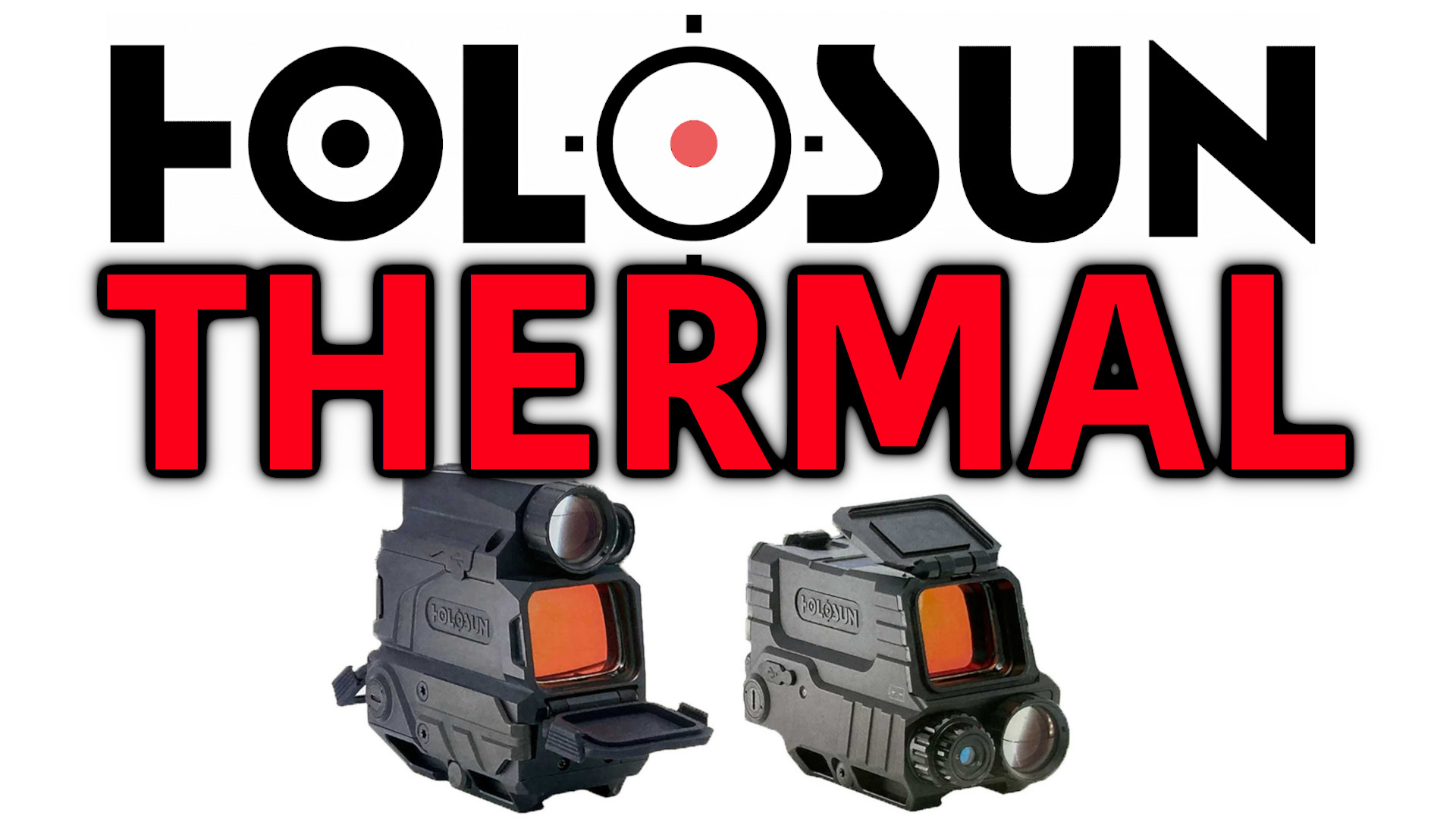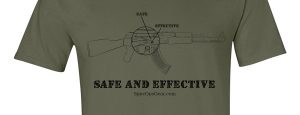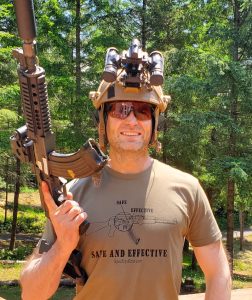Holosun Thermal Red Dot (DRS)
Almost every gun guy under age 40 has heard that Holosun is coming out with a thermal reflex sight. This company provides decent quality red dot sights that seem to work and be much cheaper than top tier stuff from Eotech and Aimpoint. Are they “just as good” as Navy Seal helicopter sniper equipment. No. But, for many use cases this brand is good enough. Video games like Call Of Duty and our drive for self-preservation have catapulted night vision and thermal imaging into mainstream gun culture. The only reason why everyone doesn’t have low light capability is that both night vision and thermal units are shockingly expensive.
Affordable PVS14’s and thermal rifle scopes are generally between $2,000 and $3,000 dollars, and poverty-tier units are priced between $1,000 and $2,000. Higher end units are $4,000 and up, way up. Anyway, the internet lost its mind when the Holosun DRS line was unveiled in three trim levels night vision, thermal and thermal fusion all in a compact, light-weight and competitively priced reflex sight.
Holosun Thermal Price:
The new Holosun DRS is offered in three trim levels:
- Night Vision Only: DRS-NV $999.00
- Thermal Only: DRS-TH $1,599.00
- Night Vision & Thermal (Fusion): DRS-TH Pro $2,299.00
Holosun DRS: What we know so far
Frame rate
So far, we know that the DRS-NV comes with a digital night vision sensor with 1024×768 resolution that can process up to 60 frames per second. Based on our testing of the Sionyx Opsin digital monocular, we know that 30fps feels laggy, 60fps is a bit laggy and 90 fps is actually pretty nice. So, even though we haven’t truly put the unreleased thermal red dot through its paces yet, we can reasonably conclude that it’s digital night vision processing will probably feel a little bit laggy but still somewhat useful.
Conclusion: a bit laggy, but still useful.
Active IR Light
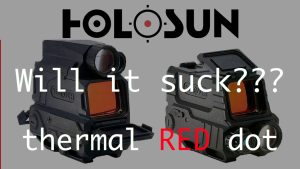
Digital night vision sensors require more ambient light than proper intensifier tubes. This means that digital units often rely heavily on active IR illumination to see clearly. If you’re hunting raccoons and coyotes in the backyard, this is no factor. But, if you’re on a two way range in a hypothetical red dawn scenario (airsoft, of course) then having a huge IR spotlight running will give your position away to anyone who matters and you’ll quickly get respawned and become a loot-drop.
The Sionyx Opsin digital night vision monocular has really raised the bar in low light sensitivity, but it’s still not quite as good. But, the Opsin runs about $2,499- these days, so I’m doubtful that Holosun’s digital low light sensor is just as good with a sticker price of $999.00 for the NV only model. Probably useful for pest control, but you’ll most likely need an active IR weapon light that would give your position away to near-peer opponents.
Conclusion: Okay for pest control, beware of near-peer opponents.
Thermal Sensor
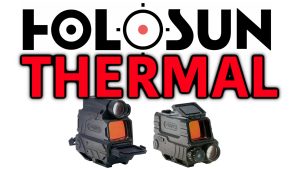
The basic Price for the thermal only unit is $1,599; which with a 320×240 core thermal sensor. But, you do need to understand that 320 core at or a bit below the minimum acceptable resolution for a budget thermal scope these days. If you want high resolution thermal, you must have at least a 640 core unit. Unfortunately, most 640 core weapon sights are in the $4,000-$6,000 price range, with a few units like the AGM Rattler TS35-640 coming in at $3,845- MSRP. What does this mean to you the consumer? It means that at 1x magnification and a 320 core thermal sensor, the Holosun will likely be useful inside 50 yards and you may get out to 100 yards using digital zoom but the image quality will suffer greatly.
If you move up to the DRS-TH Pro, you get a 384×280 core thermal sensor, and some sort of digital night vision sensor. In comparison the AGM Rattler TS25 384 core ($1,999-), as its name implies, has a 384 sensor as well. For the money, the Rattler TS25 is very useful out to 150 yards in my testing of it. So,
Conclusion: The basic thermal sensor will most likely be okay, not great within 50 yards. The PRO version’s sensor is noticeably better, but the lenses, heads-up display and 1x magnification will greatly limit its effective range. I’d plan on the PRO version being useful out to 75 yards.
For Pest Control
For low light pest control, the Holosun thermal reflex sight will most likely work pretty well at close ranges. While it hasn’t been released yet, we’re excited to pair it with a suppressed 22lr for a convenient way to dispatch offending varmints quickly and quietly. Some of the high end, higher magnification thermal scopes, like our top choice InfiRay MK1 640 core, can get a bit heavy. In contrast, a compact reflex sight would be simple and most of all, light.
In our opinion, low light pest control on a suppressed 22lr or 300 blackout is the strongest use case for this much-anticipated, budget-friendly optic.
For The Prepared Citizen
Thermal red dot sights don’t really work like you think they’ll work. People seem to think that they’ll be doing CQB run and gun with the Holosun thermal red dot like it’s an Eotech. But, based on our experience with the Sig Echo3 thermal reflex sight, you cannot use them for run and gun shooting. The problem is that these sensors have a limited field of view and are weapon mounted so you can’t effectively move around in the dark without a separate head-mounted night vision device. But, thermal viewing screens are way too bright for passive aiming through NVG. I suppose you could wear a PVS14 on your non-dominant eye, but there’s still one glaring flaw in this strategy that cannot be overcome.
When you look at tactical low light devices, they all have two things in common: they all have short eye relief and they all come with rubber eye cups. The short eye relief and rubber eye cups are there because the light pollution coming off of low light devices will light up your face like a Christmas Tree to any near peer opponents. Fundamentally, thermal reflex sights have lit LCD screens and very long eye relief will make you extremely vulnerable to anyone with a basic PVS14. For this reason, we think that budget conscious prepared citizens would be much better off with something like the AMG Rattler TS25-384 or the TS35-384. If you have a bit more money, then either the InfiRay iRay Rico RH35 MK1 640 2x 35mm or the InfiRay iRay RICO RH50 640 MK1 3x are a quantum leap forward in technology if you have the funds.
Conclusion: If you used the Holosun thermal reflex sight against any near-peer opponent you’ll get smoked.
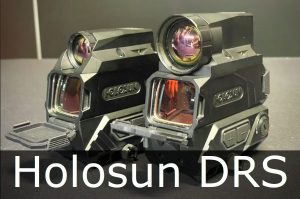
Final thoughts
The Holosun Thermal Red Dot does offer a lot of compelling features at a very competitive price point. While the thermal sensor is not top tier, it’s in line with offerings from established players like AGM. The best things about the Holosun appear to be low price and light weight. The biggest con of the unit will most likely be the fact that it will light up your face to near-peer threats on a two way range. The best thermal scope we’ve used up to this point is the iRay RH50, but that one costs over twice as much as this optic. If you’re considering the Holosun thermal red dot, also consider the AGM Rattler TS25 384 core.
Due to market demand, we’ll definitely get this new thermal reflex sight in stock as soon as we can. We’ll put it through a full and detailed evaluation as soon as possible.
Pros: Light Weight, Low Price.
Cons: Budget-tier thermal sensor, terrible against near peer threats with NVG.
